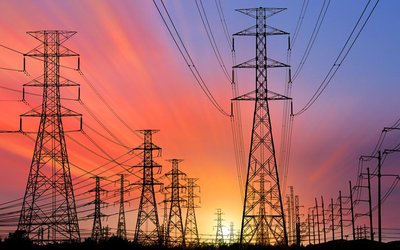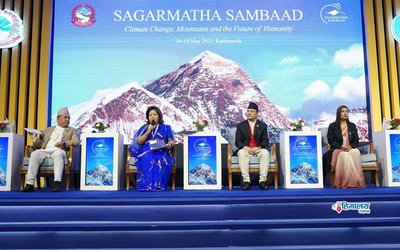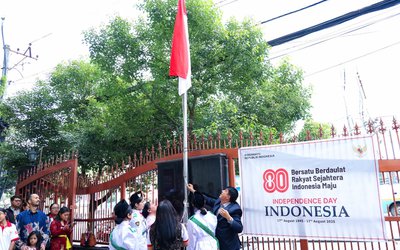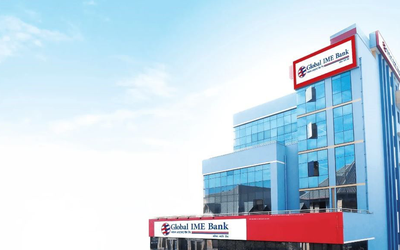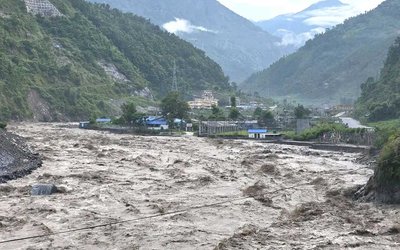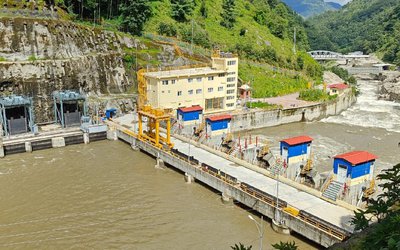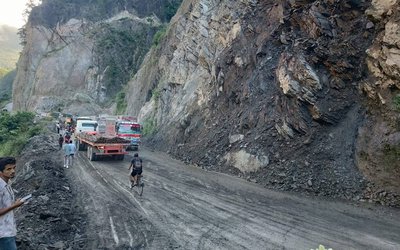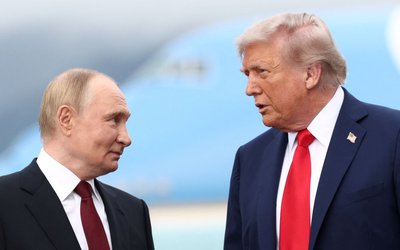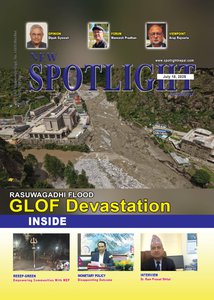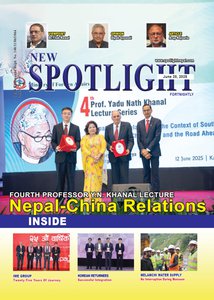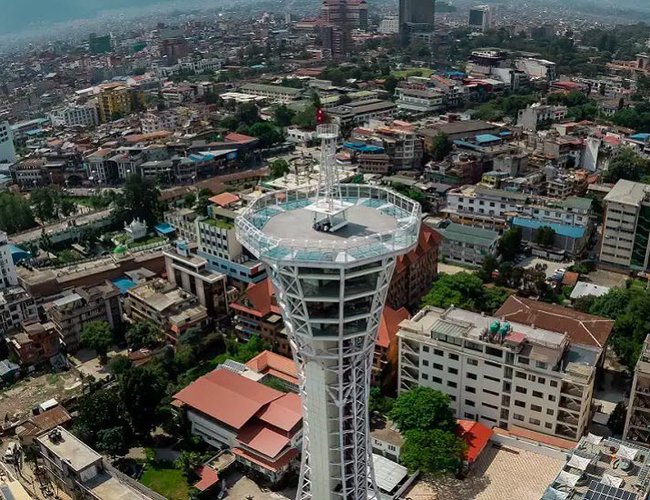
Several projects have prepared Supplementary Environmental Impact Assessment (SuEIA) in the recent years in Nepal. Two weeks back, the Ministry of Forests and Environment (MoFE) made SuEIA of a Skywalk Tower Project public. The Wonders Nepal (Pvt.) Ltd is operating this Tower to advance adventure tourism.
Located at Kamaladi, Kathmandu, theSkywalk Towerhas submitted SuEIA report to MoFE for necessary approval to add Bungee Jump (60m height), Free Fall Jump (60m height), Swing (10m height), Sky Chair. Tower Climbing, Zip-Line (200m length), Sky Bar, Sky Cycle, Reverse Bungee (40m length), Hammock Ride (150m length), Hanging Room, Revolving Restaurant, Selfie Point, Snow Room,and High Rope Course (12mx15m). It seems that two cantilevers, each 5m long, will be constructed at both sides of the existing Tower to develop a platform for Bungee and Reverse Bungee.For additional facilties, the proponent will neither add land nor construct infrastructure or increase floors beyond 75m. However, additional facilities may attract more tourists (about 450-500 people a day) and if so, water requirement is predicted to increase by 4,500 litre/day; solid waste production will increase by 18 kg/day; and liquid waste by 6 kilo litres/day.
This report mentions 'revised' EIA, and is conducted to 'formulate guiding document for environmentfriendly construction and operation of Skywalk Tower.' The report also mentions 'supplemental' EIA while the environmental law requires 'supplementary' EIA raising issue for using a proper word.
Nepal's Environment Protection Act (EPA, 2019) defines SuEIA 'an EIA to be made again vis-à-vis a proposal submitted in order to make revision partly in physical infrastructure, design or form, transfer or alter a structure, add a forest area or increase the project capacity on the EIA proposal which has been already accepted'. Section 11 of the Act provisions to conduct SuEIA '... of any project of which the EIA report has been approved.' Rules 11 of the Environment Protection Rules (EPR, 2020) exempts the preparation of the Scoping Document and the Terms of Reference (ToR) with the understanding that they are prepared and approved for EIA report preparation. However, SuEIA should follow other legal requirements for its approval such as public hearing, inclusion of the Environmental Management Plan (EMP), and making the SuEIA report public etc. The Rules also provision to issue permission to implement the project by simply revising the EMP, included in the approved EIA report.
This 75m high Skywalk Tower has already been constructed and is now under operation. Its previous EIA report was approved on BS 2078/12/06. It plans to add adventure facilities, listed above. This addition will not change the land use as the Skywalk Tower structure is in place.Due to exemption on ToR, what should be assessment during SuEIA is unclear. The report mentions: (i) field visit was conducted from BS 2081/04/32 to 2081/05/02; (ii) a public hearing was held on BS 2081/05/02 (last day of thefield visit); (iii) a 7-day public notice was published on BS 2081/05/07; and (iv) recommendation letter was obtained from the Ward Office after a week of public notice.
The SuEIA report looks like an EIA report of the rural-area-based infrastructure project.The report does not differentiate the 'impacts' and 'issues'. It seems major impact would be related to 'workers' health and safety' during the addition of new facilities, 'occupational health and safety' during its operation, and 'emergency rescue of adventure tourists or visitors'. This over 200-page SuEIA report includes several environmental impacts which might have been in the approved EIA report of this Skywalk Tower. The 24-page long write-ups on review of policies, strategies, laws, guidelines, and standards do not justify the benefits and outcomes of such a review. The alternative analysis attempts to analyse environmental impacts of 'with' and 'without' project and selects 'with project' alternative. However, it does not analyse alternatives 'within project'. The impact matrix provides a column to write activities of the proposal, but it does not mention the activity. Under impacts, SuEIA report mentions 'issues' such as related to occupational safety and health, health and sanitation, gender inequality etc. or 'impacts' and 'issues' are synonymous used.The report is silent on new environmental impacts of high significance from additional facilities.
A table which looks like an EMP is included in the report without introducingit. The report mentions NRs. 82 Crore has been spent. AdditionalNRs 7 crore is estimated for capacity enhancement of the Skywalk Tower. A total of NRs. 16 lakh 70 thousand is estimated for environmental managementwhich comes to about 2.38 percent of the estimated capacity enhancement cost.
The SuEIA report mentions land instability, water resources, socio-economic development etc for environmental monitoring. Monitoring indicators are not linked to benefits enhancement or adverse impacts mitigation measures. Auditing indicators are also unlinked. Some unlinked information amongst baseline, impacts, measures and its implementation plan, monitoring and auditing indicatorsexist in the report.
In principle and previous practice, public hearing is conducted after the preparation of the draft SuEIA report to let the local people know the significant impacts during the project construction and operation stages, and enhancement and mitigation measures proposed. In this case, a public hearing is conducted on the last date of the field visit. The same happens with the public notice without the draft report. Rules (8) of EPR (2020) provision for the submission of the recommendation letter of the Local level. For this project, the Ward Office issued the recommendation letter.
Provisions on public hearing and recommendation letter in EPA (1996) and EPR (1997) which were repealed by EPA (2019) were appropriate in principle, global practice and the procedure. Once the draft EIA report is prepared, the proponent should organise a public hearing at the project site to let the project-affected people know about major environmental impacts, both beneficial and adverse, and mitigation measures proposed. Project site was mentioned in the 1997 Rules as the public hearing of the Arun-3 hydroelectricity project was organised in Kathmandu in early 1990s. Regarding the recommendation letter, the proponent should finalise the report based on issues, views and concerns raised during the public hearring and submit it to the municipality which should ensure that issues and concerns raised at the public hearing are fully addressed. This recommendation letter is issued by the municipality 'on-behalf of the project-affected people' with the understanding the municipality should function as the 'guardian' of the project-affected people and natural resources. This mid-1990s principle-based legal provisions are sufficiently violated in this SuEIA report.
This report calls for rethinking the importance and benefits of SuEIA with conceptual, technical and legal clarities. As many projects started taking advantage of SuEIA and SuEIA is carried out without technical justification, it is high time to rethink and enhance understanding on this predictive tool. Local people, environmental communities, proponents, and the government - local to national governments should understand the benefits and requirements of the SuEIA properly.
The environmental law clearly mention the need for SuEIA for the prescribed projects after approval of the EIA report and before the project construction as per the legal criteria mentioned above. Is it necessary to carry out SuEIA beforeenhancement or reduction to the original capacity of the project during its operational stage? Is this SuEIA technically and legally necessary?
After approval of this SuEIA report, the Skywalk Tower may add new facilities mentioned above. If this Skywalk Tower again plans to increase, let us assume, the height of the Tower, and add other facilities in the same area without affecting the land use, does it again technically require SuEIA? Can it be handled by improving the EMP as per the legal provision? Are environmental monitoring and auditing report prepared and made public as per the previous EIA report? Does it consider the assessment of environmental impacts of the 'to be added facilities' only? Several issues emerged from this SuEIA report.One should understand the role of SuEIA in making the project environment-friendly. Is it technically appropriate to improve the EMP and minimise SuEIA to project like this Tower?
The approving agency is encouraged to review the monitoring and auditing reports of this Skywalk Tower to know level of compliance to the EMP, understand the effectiveness of the enhancement and mitigation measures, and verify the applicability of measures proposed in this SuEIA report. Preparation of non-implementable report is simply a burden to the proponent and it will not improve the environmental quality and reduce project-induced adverse impacts.

Batu Uprety
Former Joint-Secretary and Chief of Climate Change Management Division, Ministry of Environment (then), and former Team Leader, National Adaptation Plan (NAP) formulation process. E-mail: upretybk@gmail.com
- NDC3IP Formulation Process Launched
- Aug 10, 2025
- Approval Of EIA-Related First And Last Reports At Once
- Jun 14, 2025
- Two Calls For Climate Action From Kathmandu
- May 21, 2025
- Teaming up Climate Change Negotiation
- Apr 18, 2025
- Sagarmatha Sambad: Likely Bearing the Fruits
- Mar 27, 2025


